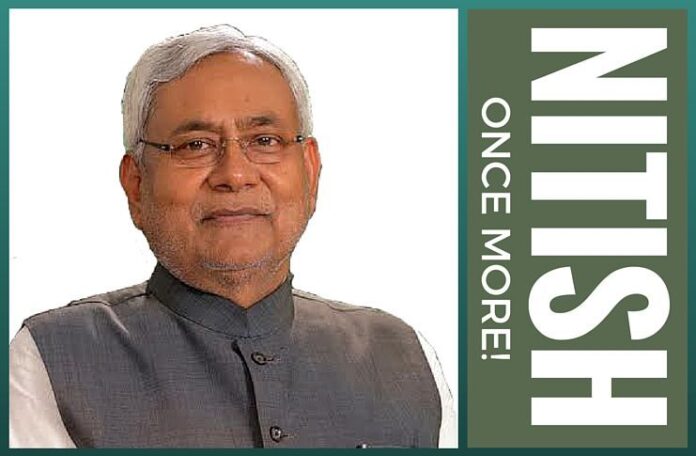
New Delhi
[dropcap color=”#008040″ boxed=”yes” boxed_radius=”8px” class=”” id=””]B[/dropcap]ihar chief Minister Nitish Kumar is all set to return to power for a third straight term. On the basis voting trend of the ongoing fifth round The PerformanceGurus predicts that the Grand Alliance will win around 135-40 seats and the NDA around 100-110 seats.
At the end of the fourth round, we predicted that the Grand Alliance was set to win around 96 seats and the NDA 90. But the fifth phase contest for 57 seats could turn out to be a one-sided affair in which the Grand Alliance might win as many as 40 seats. Add this to 96 seats at the end of the fourth round and the tally stands at 136. With a margin of error of seven to eight seats on either side, Nitish Kumar should be back in the saddle. Of course, pollsters, punters as well as journalists have often gone wrong in predicting the course of an election, but we have taken care to incorporate various factors before putting out this report.
NDA prospects could also have been marred by tactical voting by Rajputs, who reportedly opted for their own caste men over party affiliation
Incidentally, even at the peak of Prime Minister Narendra Modi’s popularity in the Lok Sabha polls, the BJP had won just two out of nine seats in the region that is going to polls today.
Here is blow-by-blow account of how the poll progressed according to our estimates:
FOURTH PHASE
[dropcap color=”#008040″ boxed=”yes” boxed_radius=”8px” class=”” id=””]F[/dropcap]eedback received from various sources — journalists, political workers, independent analysts and common voters—gives the impression that during the fourth phase the BJP might have gained an upper hand over the so-called “Grand secular alliance.” The BJP-led NDA was expected to gain a lead of around 10-12 seats over the Grand Alliance in this round by winning 33-34 seats out of 55. The Grand alliance could end up winning 21-22 seats.
PerformanceGurus had assessed that at the end of the third round the NDA was poised to get 56 seats and Grand alliance 75 seats. Going by that assessment, at the end of the fourth round NDA’s is estimated to narrow the gap with a combine tally of around 90 seats whereas the Grand Alliance might be marginally ahead, winning 96 seats.
In the fourth round, the NDA did remarkably well in Muzaffarpur where it could hope to win at least seven out of 10 seats. The BJP-led alliance could also lead in East and West Champaran , winning 13 out of 21 seats. But the grand alliance may gain upper hand in Siwan where it can win four out of six seats and Gopalganj where it is expected to capture three seats.
Sources said that the higher turnout was partially due to aggressive casteist and communal campaign launched by both the sides ahead of the fourth phase. While the Grand Alliance leaders have continued harping that the BJP was conspiring to snatch away from the Dalits and Other backward castes the benefit of reservation in job and educational institution, Prime Minister Narendra Modi has tried to balance it by accusing Nitish Kumar and Lalu Prasad of plotting to give five per cent reservation to Muslims.
THIRD PHASE
[dropcap color=”#008040″ boxed=”yes” boxed_radius=”8px” class=”” id=””]L[/dropcap]ed by Union Minister Arun Jaitley, a late entrant in the battle of Bihar, BJP’s spin doctors might have claimed a clean sweep in the third phase of the ongoing assembly polls, but the ground reports did not suggest such a reversal of trend. The factors (split in Kushwaha and Mahadalits votes) that were widely reported in the first two phases dogged the prospects of the BJP-NDA in the third phase too. In many places, NDA prospects could also have been marred by tactical voting by Rajputs, who reportedly opted for their own caste men over party affiliation. In previous Bihar elections also, Rajput voting has shown similar trends when it came to choosing between party loyalty and caste preference.
The R factor will be in play at many seats in Saran district, where the BJP was hoping to make major gains.
Conversely, the core vote of the Maha Gathbandhan (Grand alliance) remained largely intact so far. In fact, Yadav, Muslims, Kurmis and Dhanuks, the four castes which form the backbone of the Grand alliance, buried their likes and dislikes and threw their weight behind a common candidate.
Another important factor that would weigh against the NDA was comparatively lower turnout of its voters on the polling booths. While Yadavs, Muslim, and Kurmis turned out in large numbers, feedback from the ground level suggests that the same was not the case with the Upper caste supporters of the NDA. Also, the fact that the percentage of women turnout was higher than men is something that could tilt the balance in the favour of the Grand Alliance. Anyone traveling across the rural belt of Bihar can easily understand that Nitish Kumar’s scheme to provide free bicycles and school uniforms to girls and reservation to women in panchayats have created for him a big constituency of voters.
According to estimates, the Grand alliance is expected to win six of the seven seats in Nalanda, two each in Buxar and Bhojpur, five each in Saran and Patna, and four in Vaishali. This will mean out of the 50 seats at stake in the third round, the Grand Alliance could win 24 seats and NDA 26 seats. However, the final tally could see a change of four to five seats on either side.
In the first two phases, PerformanceGurus predicted the Grand alliance to lead by 50-31. After the third round, we expect the Grand alliance to lead by 75-57, subject to a reasonable margin of errors that all forecasts entail.
FIRST and SECOND PHASES
[dropcap color=”#008040″ boxed=”yes” boxed_radius=”8px” class=”” id=””]T[/dropcap]he feedback of the first two phases of poll for 81 out of 243 seats for the Bihar assembly sent shockwaves in the BJP, forcing it to recalibrate its strategy for the next three phases.
Reports from the ground suggested that a large section of the Kuswahas voted for the “grand alliance” led by Nitish Kumar. This was a serious cause of concern for the NDA because it was counting on a cornering en bloc support of the six percent Kuswahas due to the presence of Upendra Kuswaha in the BJP-led alliance. As per reports, Kuswaha voters felt disenchanted with lower representation given to their candidates by the NDA in comparison to the Grand alliance. In many cases, the Kuswahas voters also backed their caste candidates put up by other parties.
Similarly, among the 16 per cent Dalits and Mahadalits, while Paswans and Manjhis voted for the NDA in large numbers, Chamars, Pasi and others went either with the Grand alliance or the Bahujan Samjwadi party led by Mayawati.
Kuswahas, Dalits and Mahadalits have sizeable presence in the assembly segments where elections were held in the first two phases. The BJP had expected to do very well, espececially in the second phase, but reports from different quarters suggest that it cannot expect to get more than 17-18 seats out of 32 in this round. In the first phase, the party was likely to be routed and could hope to get a maximum of 15 seats. Put together in the first two phases, the NDA could bag 31-33 seats and the Grand Alliance 48-50.
- The rise of Patanjali:An Indian yogi’s challenge to MNC giants - January 26, 2016
- Padmas – a blend of excellence, politics and ideology - January 25, 2016
- Scared of hispopularity, British wanted to hang Netaji - January 24, 2016











What a joke. Journalists turning sooth-sayers.
The analysis suggests of a stable government with equally strong opposition.hope it benefited the junata for which they fought bitterly.